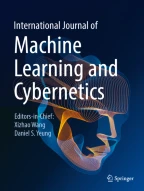Abstract
Autoencoder can learn the structure of data adaptively and represent data efficiently. These properties make autoencoder not only suit huge volume and variety of data well but also overcome expensive designing cost and poor generalization. Moreover, using autoencoder in deep learning to implement feature extraction could draw better classification accuracy. However, there exist poor robustness and overfitting problems when utilizing autoencoder. In order to extract useful features, meanwhile improve robustness and overcome overfitting, we studied denoising sparse autoencoder through adding corrupting operation and sparsity constraint to traditional autoencoder. The results suggest that different autoencoders mentioned in this paper have some close relation and the model we researched can extract interesting features which can reconstruct original data well. In addition, all results show a promising approach to utilizing the proposed autoencoder to build deep models.
Similar content being viewed by others
Explore related subjects
Discover the latest articles, news and stories from top researchers in related subjects.Notes
MNIST-Rotation dataset http://www.iro.umontreal.ca/~lisa/twiki/bin/view.cgi/Public/MnistVariations.
M. Schmidt. minFunc: unconstrained differentiable multivariate optimization in Matlab. http://www.cs.ubc.ca/~schmidtm/Software/minFunc.html, 2005.
References
Hinton GE, Salakhutdinov RR (2006) Reducing the dimensionality of data with neural networks. Science 313:504–507
Bengio Y, Lamblin P, Popovici D, Larochelle H (2007) Greedy layer-wise training of deep networks. Neural information processing system foundation, Vancouver, pp 153–160
Vincent P, Larochelle H, Bengio Y et al (2008) Extracting and composing robust features with denoising autoencoders. ICML’08. ACM, New York, pp 1096–1103
Baldi P (2012) Autoencoders, unsupervised learning, and deep architectures. ICML Unsuperv Transf Learn 12:37–50
Almousli H, Vincent P (2013) Semi supervised autoencoders: better focusing model capacity during feature extraction. In: Neural Information Processing. Springer, Berlin, Heidelberg, Germany, pp 328–335
Baldi P, Lu Z (2012) Complex-valued autoencoders. Neural Netw 33:136–147
Luo Y, Wan Y (2013) A novel efficient method for training sparse auto-encoders. IEEE International Congress on Image and Signal Processing. Hangzhou, China, pp 1019–1023
Wei W, Yan H, Yizhou W et al (2014) Generalized autoencoder: a neural network framework for dimensionality reduction. In: 2014 IEEE Conference on Computer Vision and Pattern Recognition Workshops Columbus. OH, USA, pp 496–503
Chandra B, Sharma RK (2014) Adaptive noise schedule for denoising autoencoder. In: Neural Information Processing, Springer, Switzerland, pp 535–542
Liu J, Chi G, Liu Z et al (2013) Predicting protein structural classes with autoencoder neural networks. In: 25th Chinese Control and Decision Conference (CCDC2013). Guiyang, pp 1894–1899
Ouyang Y, Liu W, Rong W et al (2014) Autoencoder-based collaborative filtering. In: Neural Information Processing. Springer, Switzerland, pp 284–291
Tan CC, Eswaran C (2008) Reconstruction of handwritten digit images using autoencoder neural networks. In: International Conference on Electrical & Computer Engineering. Niagara Falls, pp 442–446
Krizhevsky A, Hinton GE (2011) Using very deep autoencoders for content-based image retrieval. In: 2011 European Symposium on Artificial Neural Networks. Bruges, Belgium, pp 27–29
Xia B, Bao C (2014) Wiener filtering based speech enhancement with weighted denoising auto-encoder and noise classification. Speech Commun 60:13–29
You Q, Zhang Y-J (2013) A new training principle for stacked denoising autoencoders. In: Seventh International Conference on Image and Graphics. Qingdao, pp 384–389
Wu K, Gao Z, Peng C, Wen X (2013) Text window denoising autoencoder: building deep architecture for Chinese word segmentation. Commun Comput Inf Sci 400:1–12
Zheng Y, Jeon B, Xu D et al (2015) Image segmentation by generalized hierarchical fuzzy C-means algorithm. J Intell Fuzzy Syst 28:961–973
Ding S, Zhang J, Jia H, Qian J (2015) An adaptive density data stream clustering algorithm. Cognit Comput 8:30–38
Gu B, Sun X, Sheng VS (2016) Structural minimax probability machine. IEEE Trans Neural Netw Learn Syst 1–11
Lu S, Wang X, Zhang G, Zhou X (2015) Effective algorithms of the Moore–Penrose inverse matrices for extreme learning machine. Intell Data Anal 19:743–760
LeCun Y, Ranzato MA, Poultney C et al (2006) Efficient learning of sparse representations with an energy-based model. Nips 1:1137–1144
Lee H, Ekanadham C, Ng AY (2009) Sparse deep belief net model for visual area V2. In: 21st Annu. Conf. Neural Inf. Process. Syst. 873–880
Xi-Zhao W, Qing-Yan S, Qing M, Jun-Hai Z (2013) Architecture selection for networks trained with extreme learning machine using localized generalization error model. Neurocomputing 102:3–9
Wang X, Chen A, Feng H (2011) Upper integral network with extreme learning mechanism. Neurocomputing 74:2520–2525
You Z-H, Lei Y-K, Zhu L et al (2013) Prediction of protein-protein interactions from amino acid sequences with ensemble extreme learning machines and principal component analysis. BMC Bioinf 14(Suppl 8):S10
He Y-L, Wang X-Z, Huang JZ (2016) Fuzzy nonlinear regression analysis using a random weight network. Inf Sci (Ny). doi:10.1016/j.ins.2016.01.037. (in press)
Vincent P, Larochelle H, Lajoie I et al (2010) Stacked denoising autoencoders: learning useful representations in a deep network with a local denoising criterion. J Mach Learn Res 11:3371–3408
Boureau Y, Lecun Y, Ranzato MA (2007) Sparse feature learning for deep belief networks. Adv Neural Inf Process Syst 20:1–8
Lee H, Ekanadham C, Ng AY (2008) Sparse deep belief net model for visual area V2. In: Adv. Neural Inf. Process. Syst. 20. Curran Associates Inc., Computer Science Department, Stanford University, Stanford, CA 94305, United States, pp 873–880
Makhzani A, Frey B (2013) k-Sparse Autoencoders. http://arxiv.org/abs/1312.5663
Ng AY (2004) Feature selection, L 1 vs. L 2 regularization, and rotational invariance. Proceedings of the twenty-first international conference on Machine learning. In: Proc. twenty-first Int. Conf. Mach. Learn. pp 379–387
LeCun Y, Bottou L, Bengio Y, Haffner P (1998) Gradient-based learning applied to document recognition. Proc IEEE 86:2278–2323
Coates A, Arbor A, Ng AY (2011) An analysis of single-layer networks in unsupervised feature learning. Aistats 2011:215–223
Acknowledgments
This work is supported by the National Natural Science Foundation of China (No. 61379101), the Priority Academic Program Development of Jiangsu Higher Education Institutions, and the Jiangsu Collaborative Innovation Center on Atmospheric Environment and Equipment Technology.
Author information
Authors and Affiliations
Corresponding author
Rights and permissions
About this article
Cite this article
Meng, L., Ding, S. & Xue, Y. Research on denoising sparse autoencoder. Int. J. Mach. Learn. & Cyber. 8, 1719–1729 (2017). https://doi.org/10.1007/s13042-016-0550-y
Received:
Accepted:
Published:
Issue Date:
DOI: https://doi.org/10.1007/s13042-016-0550-y
